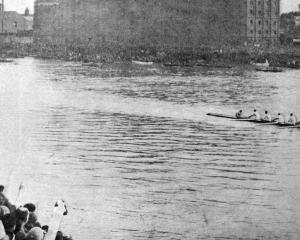The inspector ordered these apples to be opened up and fumigated before being carted to the auction marts, and he also stated that, for the future, such fruit would not be allowed to be landed at all.
The appearance of the fruit, on opening the case, had very much deteriorated, first by the fact that the apples had not been repacked as well as it was done in the orchards by the experts, and secondly, that the fruit had suffered very much by the repacking.
The paper had to be removed before the Government officials would fumigate the fruit.
Mr Moritzson, the auctioneer, stated that it was owing to representations being made by Dunedin auctioneers, pointing out that prices were holding fairly high in Dunedin, that shipments had been coming forward from Tasmania to this market.
Mr Moritzson added that the Tasmanian growers could get better prices in New South Wales, where there were no restrictions, and as the Dunedin market was already under-supplied with apples, the values might go up to famine prices.
• An unusual sight is to be seen on the Racecourse road in the vicinity of the entrance to the course (says the Southland Times).
In these days of high prices for foodstuffs, and the general complaint of the difficulty in making ends meet, the sight referred to would have gladdened the eyes of many a housewife if the goods have been in a sound state.
In the racecourse reserve there is a fairly large lagoon, in which a number of ducks disport themselves, and, as is well known, they have a peculiar preference for laying their eggs in water as against a nest, and, in consequence, the eggs are lost.
It is evident that the pond had been cleaned out, and the discovery made of hundreds of duck eggs, of course, all past the useful stage.
These have been carted out of the course and deposited on the roadside, and what would have been a valuable marketable commodity has been wasted.
• A rat has been received from Hastings by our columnist Magister, who has this to say about it: It is the black rat probably introduced into New Zealand by Captain Cook, and known to be arboreal in its habits, for it came originally from India, where it is often found in trees living on fruits and other vegetable articles.
Briefly, there are three rats to be noticed in connection with the zoology of New Zealand - the Mus maorium, or Kiore, the rat which tradition says the Maoris brought in a box in one of their canoes to breed as a table delicacy; the Mus rattus, or black rat, which was introduced - not intentionally, of course - by Captain Cook, or subsequent navigators; and the Mus decumanus, the Norwegian rat - improperly so called, the Wanderer would be a more suitable name - which has almost exterminated the black rat.
The specimen sent is the M. rattus, or black rat, a good specimen, too, for it had a beautiful bluish-black fur.
Professor Benham, at a meeting of the Otago Institute, described it, and had on exhibition the Maori rat - much the same in size, but fur not so dark.
• A curious noise emanating from the ceiling of the Invercargill Police Court had been attracting speculation, because it was known that birds could not enter from the roof.
The other day, during proceedings, a rat fell down upon a gentleman in court, and scampered away, thus solving an irritating inconvenience for those people who frequent the solemn precincts of the court. - ODT, 16.7.1914.
• COPIES OF PICTURE AVAILABLE FROM ODT FRONT OFFICE, LOWER STUART ST, OR WWW.OTAGOIMAGES.CO.NZ












